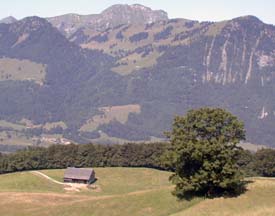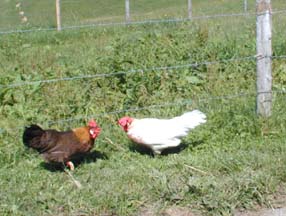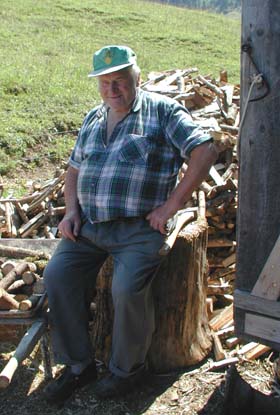LETTERS FROM THE COUNTRY:
2. VISIT TO A CHALET
Above the village is an extra world, cut by streams
and dotted with chalets, so the commune is three dimensional but with the
higher part only usable four months of the year. We went walking along
the roads which provide access, roads whose construction and maintenance
require immense efforts.  At
the second building we came to two men were chopping wood. I stopped to
watch them and one began to talk to us. It ended up by us being invited
inside.
At
the second building we came to two men were chopping wood. I stopped to
watch them and one began to talk to us. It ended up by us being invited
inside.
There were three old men, all brothers. The youngest
was inside cooking a huge meal of meat, herbed tomato halves and scalloped
potatoes on a wood burning stove and an open fire. They were celebrating
the birthday of the slim brother. They came, as is common here among the
older people, from a large family, seven in all. Another brother who normally
sleeps at the chalet was down below ill. The chalet belongs to a farmer
who hires him for the summer. They were the relief team but two of them
were clearly used to life in the chalet. They were proud of the chalet,
its living arrangements, the cows and chickens and showed us around. 
I have not heard the term alpage. The expression
used here is "the cows are at the mountain" or "at the chalet". A
few ancient chalets with rubble walls and roofs covered with shingles including
the large square chimney with a lid have been preserved. A chalet
in the mountains still in use must reach fixed standards and may be inspected.
It is usually built of concrete and other resistant materials. The area
for the cows is larger than the living area which is quite comfortable.
This one was well designed with the byre, the house and the w.c. all opening
off a covered area decorated with flowers. We saw the bedroom, the kitchen-living
room and the store. There is electricity. The name, date and height
of the chalet above sea level often figure over the entry. This one is
at 1227 metres.
The cows graze and the chalets are placed right
up to the ridges of the mountains. Only cliff faces are left unexploited.
Around here the steep slopes from 800 metres have been left forested
and the upper pastures go from 1000 metres upwards. Seen from below the
pastures look like clearings amid the forest. Once up at 1000 metres the
pastures sweeping over the rolling land are broken by patches of conifers.
One section of trees had been badly damaged by the great storms at the
end of 1999 and the access road widened to take out the timber.
The cows were in the byre. They were heifers
and cows which would calf in late summer and were not being milked.
We were told they were on a diet which suits them very well. At five
they would be let out and brought in again the following morning at nine.
These black and white cows are Holsteins which are a popular breed.
The other cows are mostly white with brown which ranges from deep chestnut
to sandy. The next chalet along had young goats which were also being
kept inside. In our village a goat cheese establishment was started
a couple of years ago. During the summer the milk is brought down
every morning and evening, a nine kilometre run. Now that access
has been made easy with motor vehicles, four wheel drives and many sealed
roads, farmers can manage their upper pastures from their houses in the
village. There has been considerable consolidation of holdings and
even the outlying farms in the valley are not inhabited. Still
farmers in the plain over 30 kilometres from the mountains may own alpine
grazing rights and buildings. At the weekends and during school holidays
members of the family who have migrated to town visit the chalets, particularly
on National Day.
 One brother reminded us how harsh the climate is up there. The morning
after our visit we had thunder followed by rain. When the rain clouds
are high we can see the cows up above us still grazing. More frequently,
coming from south or west, the clouds sweep over the summits and
the ridges to fill the valley and shroud the slopes from view.
One brother reminded us how harsh the climate is up there. The morning
after our visit we had thunder followed by rain. When the rain clouds
are high we can see the cows up above us still grazing. More frequently,
coming from south or west, the clouds sweep over the summits and
the ridges to fill the valley and shroud the slopes from view.
1st September 2002
Audrey Johnson
[email protected]